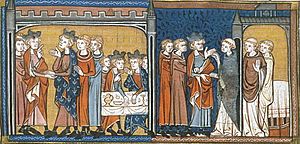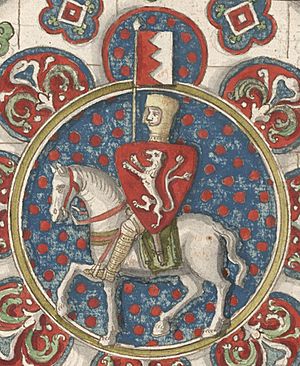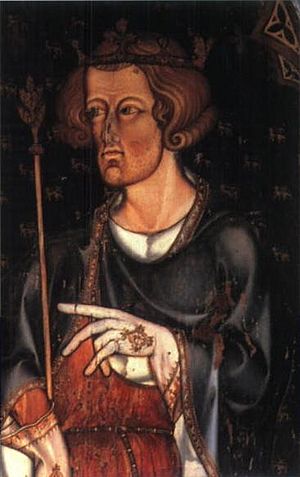Simon de Montfort's Parliament facts for kids
Simon de Montfort's Parliament was an important meeting in England, held from January to March 1265. It was called by Simon de Montfort, a powerful leader who had taken control of England.
Montfort had won a big battle against King Henry III at Lewes during the Second Barons' War. But his power was not completely safe. To get more support, he invited not only important nobles (called barons) and knights from the counties, but also people from the main towns, called burgesses. This was a new idea! They talked about big changes and helped Montfort's government for a short time.
Montfort was killed later that year at the Battle of Evesham. However, the idea of inviting both knights and burgesses to parliaments became more common. King Edward I, Henry's son, used this idea more often. By the 1300s, it was normal for these groups to meet. This gathering eventually became known as the House of Commons, which is a major part of the UK Parliament today.
Contents
How the Parliament Came About
In 1258, King Henry III of England faced a rebellion from his nobles. People were unhappy about how the King's officials were collecting money. They also disliked the influence of his French relatives and his unpopular plans for Sicily. Even the Church in England had complaints. Many felt the King was not handling the country's problems well.
On April 30, a group of nobles, including Simon de Montfort, marched into Westminster. They took control of the King's parliament in a sudden move. King Henry was afraid he would be arrested. So, he agreed to stop ruling alone. Instead, he would govern with a council of 24 nobles and churchmen. Half of these were chosen by the King, and half by the nobles.
The demand for changes kept growing. A parliament met in June. The word "parliament" first appeared in the 1230s and 1240s. It described large meetings of the royal court. These meetings happened regularly during Henry's time. They were used to agree on new taxes. These taxes were usually one-time payments on goods. They helped the King pay for special projects. During Henry's rule, counties started sending regular groups to these parliaments. These groups represented more people than just the main nobles.
The new parliament passed rules called the Provisions of Oxford. King Henry swore to follow them. These rules created a smaller council of 15 members. Only the nobles chose these members. This council could then appoint England's main officials, like the justiciar (chief judge), chancellor, and treasurer. They would also check on things through parliaments held every three years. Pressure from smaller nobles and gentry (landowners) at Oxford also helped pass wider changes. These changes aimed to stop officials and powerful nobles from misusing their power. Even stronger rules, called the Provisions of Westminster, were passed by the new council the next year.
Soon, disagreements appeared among the rebel nobles. Montfort wanted big changes that would limit the power of both the King and the main nobles even more. Other nobles wanted only small changes. Some conservative nobles worried about limiting the King's power too much. For the next four years, neither Henry nor the nobles could bring peace to England. Power shifted back and forth between different groups.
By early 1263, King Henry's power had almost disappeared. The country was heading back towards civil war. Montfort called a meeting of rebel nobles in Oxford to push his ideas. By October, England was likely facing a civil war. Montfort marched east with an army, and London revolted. Montfort captured Henry and Queen Eleanor. Even though he pretended to rule in Henry's name, the rebels completely replaced the King's government with their own trusted men.
Montfort's group quickly started to fall apart. Henry regained his freedom. Chaos spread across England again. Henry asked his brother-in-law, King Louis IX of France, to help settle the dispute. Montfort at first didn't like this idea. But as war seemed more likely, he agreed to French help too. At first, Montfort's legal arguments seemed strong. But in January 1264, Louis announced the Mise of Amiens. He sided with the King, saying the rebels were wrong. He also cancelled the Provisions of Oxford.
The Second Barons' War finally began in April. Henry led an army into Montfort's lands. Montfort, feeling desperate, marched after Henry. The two armies met at the Battle of Lewes on May 14. Even though Henry's forces had more soldiers, they were defeated. Henry was captured. He was forced to forgive the rebel nobles and bring back the Provisions of Oxford. This left him with very little real power.
Montfort's Parliament of 1265
Simon de Montfort said he was ruling in the King's name through a council. But he was actually in charge of the government. This was the first time in English history that someone who wasn't the King had such power. Montfort successfully held a parliament in London in June 1264. This meeting confirmed new rules for England. Two knights were called from each county. They were chosen by the county court. For the first time, they were allowed to talk about general matters of the country.
However, Montfort could not make his victory at Lewes permanent. There was still a lot of disorder across England. In France, Queen Eleanor planned to invade England with King Louis's help.
To respond to this, and hoping to get more support, Montfort called a new parliament. It was set for January 20, 1265, and lasted until mid-March. It was called quickly, with notices sent out on December 14. This left little time for people to get ready. He invited not only the nobles and senior churchmen, and two knights from each county, but also two burgesses from each of the main towns. These towns included York, Lincoln, Sandwich, and the Cinque Ports. This was the first time burgesses were invited!
Montfort did not have much support among the nobility. So, only 23 nobles were called to this parliament. In contrast, 120 churchmen were called, as they mostly supported the new government. We don't know how many burgesses were called. King Henry oversaw the event. It was held in the Palace of Westminster, just outside London. London was the biggest city in England, and its loyalty was very important to Montfort.
This parliament was a clever move by Montfort to gain support from different parts of the country. It was a meeting mostly of his supporters, not a fully democratic one. Again, the representatives were allowed to talk about wider political issues, not just taxes. The main goal of the parliament was to make sure the Provisions of Westminster were followed. These rules especially limited the power of the major nobles. The parliament also promised legal help to those who felt they were being treated unfairly by their feudal lords.
The parliament brought peace for a short time. But opposition grew again. This was partly because Montfort and his family started to gain a lot of personal wealth. Prince Edward, the King's son, escaped his captors in May. He formed a new army, and civil war broke out again. Edward chased Montfort's forces through Wales. Then he attacked Montfort's castle at Kenilworth. After that, he turned back to fight Montfort himself. Montfort, who had the captive King Henry with him, could not escape. The Battle of Evesham followed.
In some places, the rebellion continued even after Montfort's death. Some rebels gathered at Kenilworth. Henry and Edward took the castle after a long siege in 1266. The remaining small groups of rebels were defeated. The last rebels, hiding on the Isle of Ely, gave up in July 1267. This marked the end of the war.
What Happened Next
King Henry III ruled England until he died in 1272. He continued to call parliaments. Sometimes these included knights from the counties, and once, burgesses from the towns. After 1297, during King Edward I's rule, inviting both knights and burgesses became the usual practice. By the early 1300s, it was normal to include them. This group became known as the "Commons" of England. Eventually, they formed the "House of Commons" we know today.
Simon de Montfort's parliament of 1265 is sometimes called the first English parliament that truly represented different groups. This is because it included both knights and burgesses. Montfort himself is often seen as the founder of the House of Commons. A historian from the 1800s, William Stubbs, made the 1295 "Model Parliament" of Edward I famous as the first real parliament. However, modern experts question this idea. Historian David Carpenter calls Montfort's 1265 parliament "a landmark" in how parliament grew during the Middle Ages.
Remembering Montfort's Parliament
The Parliament of the United Kingdom sent a special message to Queen Elizabeth II in 1965. This was to mark 700 years since Montfort's Parliament. The Queen then spoke to both Houses of Parliament. The House of Lords Record Office, now called the Parliamentary Archives, held an exhibition. They showed several important old laws. Some of these documents were shown again in a 2015 exhibition.
In 2015, Parliament held a year-long series of events called "Parliament in the Making". This was part of Parliament Week. It included events to mark the 750th anniversary of Montfort's Parliament. The BBC had a "Democracy Day" on January 20. This was to match the 750th anniversary. It had live talks and debates about parliament and democracy. It was done with the Speaker's Office of the House of Commons. Parts of it were broadcast from inside the Palace of Westminster. Westminster Abbey held a special evening service on January 22. This remembered the anniversary of Montfort's parliament and how rights and representation developed.
See also




